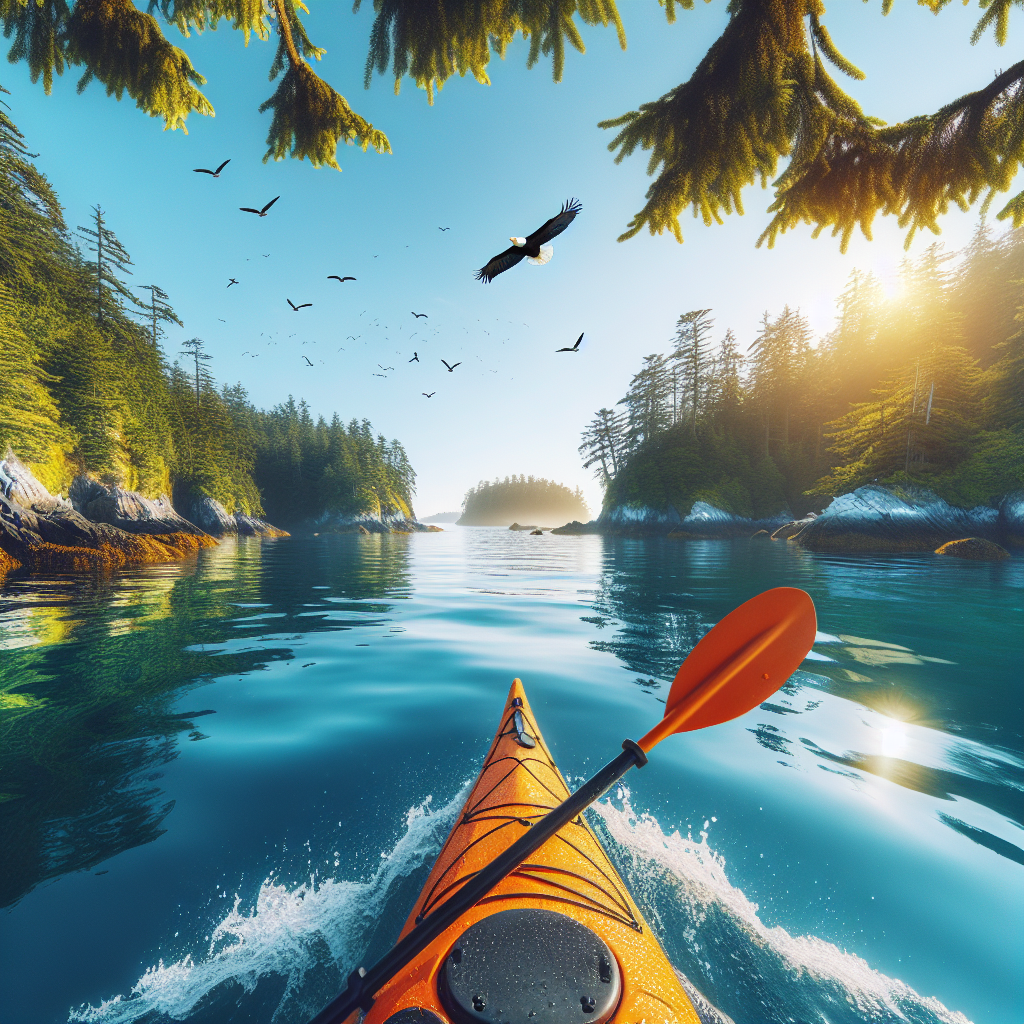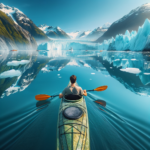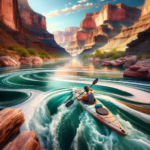Kayaking in San Juan Islands, Washington, USA
Introduction to Kayaking
Kayaking is a thrilling outdoor activity that has gained immense popularity over the years. It offers a unique way to explore water bodies, from serene lakes to roaring rivers and expansive seas. The sport combines physical exercise with the opportunity to connect with nature, making it a favorite among adventure seekers and nature lovers alike. Whether you’re paddling through calm waters or navigating challenging rapids, kayaking provides an exhilarating experience that is both refreshing and invigorating.
In this article, we will spotlight the unique features of kayaking in the San Juan Islands, Washington, USA. This destination is renowned for its stunning landscapes, diverse wildlife, and excellent kayaking conditions. Our goal is to provide you with a comprehensive guide to kayaking in this beautiful region, covering everything from the best spots to safety tips and environmental considerations.
What makes the San Juan Islands a unique spot for kayaking is its combination of natural beauty and rich biodiversity. The archipelago consists of over 170 islands, each offering its own unique charm and kayaking opportunities. From the chance to see orcas in their natural habitat to exploring hidden coves and beaches, kayaking in the San Juan Islands is an experience like no other.
Overview of Kayaking in San Juan Islands, Washington, USA
The San Juan Islands are located in the northwest corner of Washington State, nestled between the mainland and Vancouver Island, Canada. The archipelago’s geography is characterized by rugged coastlines, lush forests, and crystal-clear waters, making it an ideal destination for kayaking. The islands have a mild maritime climate, with cool summers and mild winters, providing favorable conditions for kayaking year-round.
Historically, the waters around the San Juan Islands have been used for transportation and fishing by indigenous peoples for thousands of years. Today, the islands are a popular destination for water sports enthusiasts, including kayakers. The region’s rich cultural heritage and natural beauty make it a fascinating place to explore by kayak.
Visitors can access the San Juan Islands by ferry from Anacortes, Washington, or by private boat. There are also several airports on the larger islands, making it easy to reach the archipelago from major cities like Seattle and Vancouver. The best times to visit for kayaking are during the spring and summer months when the weather is warm and the waters are calm.
Kayaking Conditions in San Juan Islands, Washington, USA
The waters around the San Juan Islands are part of the Salish Sea, a complex network of coastal waterways that includes the Strait of Georgia, the Strait of Juan de Fuca, and Puget Sound. The sea’s relatively calm waters make it an excellent location for kayaking, whether you’re a beginner or an experienced paddler. The islands’ sheltered bays and inlets provide additional protection from wind and waves, ensuring a smooth and enjoyable kayaking experience.
The typical weather conditions in the San Juan Islands vary throughout the year. Summers are generally warm and dry, with temperatures ranging from the mid-60s to mid-70s Fahrenheit. Winters are mild, with temperatures rarely dropping below freezing. However, the region does experience occasional rain and fog, so it’s essential to check the weather forecast before heading out on the water.
Tides and currents are significant factors to consider when kayaking in the San Juan Islands. The region experiences substantial tidal fluctuations, which can create strong currents in certain areas. It’s crucial to plan your kayaking trips around the tides and to be aware of any potential hazards. Local tide charts and current maps are valuable resources for kayakers.
Environmental factors such as water temperature and marine life also impact kayaking conditions. The waters around the San Juan Islands are relatively cold, even in the summer, so wearing appropriate gear like a wetsuit or drysuit is recommended. Additionally, the region is home to a diverse array of marine life, including orcas, seals, and sea lions, which can enhance your kayaking experience but also require caution and respect.
Top Spots for Kayaking in San Juan Islands, Washington, USA
One of the top spots for kayaking in the San Juan Islands is Lime Kiln Point State Park on San Juan Island. Known as one of the best places in the world to see orcas from the shore, this area offers kayakers the unique opportunity to paddle alongside these magnificent creatures. The park’s rugged coastline and scenic views make it a must-visit destination for any kayaking enthusiast.
Another popular kayaking spot is the waters around Orcas Island, the largest of the San Juan Islands. The island’s diverse coastline features hidden coves, sandy beaches, and rocky outcroppings, providing a variety of paddling experiences. Moran State Park, located on Orcas Island, offers excellent kayaking opportunities on its freshwater lakes, making it a great option for those looking to explore both saltwater and freshwater environments.
Shaw Island, the smallest of the four main San Juan Islands, is a hidden gem for kayakers. Its quiet, undeveloped shoreline offers a peaceful and secluded paddling experience. The island’s calm waters and abundant wildlife make it an ideal spot for beginners and those looking to escape the crowds.
Lopez Island, known for its gentle terrain and friendly community, is another fantastic kayaking destination. The island’s protected bays and inlets provide calm waters perfect for leisurely paddling. Spencer Spit State Park on Lopez Island is a popular launch point for kayakers, offering easy access to nearby islands and marine parks.
Safety and Regulations
Safety is paramount when kayaking in the San Juan Islands. Local regulations require all kayakers to wear a personal flotation device (PFD) at all times while on the water. It’s also essential to carry a whistle or other sound-producing device to signal for help if needed. Additionally, kayakers should be aware of the “Rules of the Road” for navigating waterways and always yield to larger vessels.
Recommended safety gear includes a wetsuit or drysuit to protect against cold water temperatures, a bilge pump or sponge for removing water from your kayak, and a paddle float for self-rescue. It’s also a good idea to carry a waterproof map, a compass or GPS device, and a first aid kit. Always let someone know your planned route and estimated return time before heading out.
In case of emergency situations, it’s crucial to stay calm and assess the situation. If you capsize, try to stay with your kayak and use your paddle float to re-enter the boat. If you’re unable to re-enter, signal for help using your whistle or other sound-producing device. It’s also important to be aware of hypothermia symptoms and know how to treat them.
Local kayaking guides and tour operators can provide valuable safety information and support. Many offer guided tours that include safety briefings and equipment checks, ensuring a safe and enjoyable kayaking experience. Whether you’re a beginner or an experienced paddler, taking a guided tour can enhance your understanding of the local environment and improve your kayaking skills.
Amenities and Accommodations
The San Juan Islands offer a range of amenities to support your kayaking adventure. Several rental facilities provide kayaks, paddles, and safety gear, making it easy to get out on the water even if you don’t have your own equipment. Many of these facilities also offer guided tours and lessons for those looking to improve their skills or explore the islands with an experienced guide.
Accommodation options in the San Juan Islands are diverse, catering to various preferences and budgets. From charming bed and breakfasts and boutique hotels to campgrounds and vacation rentals, there’s something for everyone. Popular lodging options include the Roche Harbor Resort on San Juan Island and the Doe Bay Resort on Orcas Island, both of which offer easy access to prime kayaking spots.
For those who prefer camping, several state parks in the San Juan Islands offer campgrounds with facilities like restrooms, showers, and picnic areas. Moran State Park on Orcas Island and Spencer Spit State Park on Lopez Island are popular choices for campers and kayakers alike. These parks provide a convenient base for exploring the islands’ waterways and natural beauty.
In addition to kayaking, the San Juan Islands offer a variety of recreational activities for visitors to enjoy. Hiking, biking, and wildlife watching are popular pursuits, with numerous trails and parks to explore. Whale watching tours, fishing charters, and sailing excursions are also available, providing additional ways to experience the region’s stunning landscapes and rich marine life.
Environmental Considerations
Preserving the natural habitats and wildlife of the San Juan Islands is of utmost importance. Kayakers should practice Leave No Trace principles, which include packing out all trash, minimizing campfire impact, and respecting wildlife. Avoid disturbing marine animals by keeping a safe distance and not feeding them. It’s also essential to stay on designated trails and campsites to protect fragile ecosystems.
Eco-friendly kayaking practices include using biodegradable sunscreen and avoiding single-use plastics. Consider bringing reusable water bottles and containers for snacks to reduce waste. Additionally, be mindful of your impact on the water by avoiding areas with sensitive marine vegetation and not dragging your kayak over rocks or coral.
Several local conservation efforts and projects aim to protect the San Juan Islands’ unique environment. Organizations like the San Juan Preservation Trust and Friends of the San Juans work to preserve natural habitats, promote sustainable practices, and educate visitors about the importance of conservation. Supporting these organizations through donations or volunteer work can help ensure the islands remain a pristine destination for future generations.
Participating in local conservation efforts can also enhance your kayaking experience. Many guided tours include educational components that highlight the region’s ecology and conservation challenges. By learning about the local environment and contributing to its preservation, you can enjoy a more meaningful and responsible kayaking adventure.
Highlights
When comparing kayaking in the San Juan Islands to other popular kayaking destinations, several unique features stand out. The region’s rich biodiversity, including the chance to see orcas, seals, and sea lions, sets it apart from many other locations. The islands’ diverse landscapes, from rugged coastlines to serene freshwater lakes, offer a variety of paddling experiences that cater to different skill levels and interests.
Geographically, the San Juan Islands’ location within the Salish Sea provides relatively calm waters and sheltered bays, making it an ideal destination for kayaking. The region’s mild maritime climate also allows for year-round kayaking opportunities, unlike some other destinations that may have more extreme weather conditions.
Historically, the San Juan Islands have a rich cultural heritage tied to the indigenous peoples who have lived in the region for thousands of years. This cultural significance adds depth to the kayaking experience, as visitors can explore areas that have been used for transportation and fishing for generations. The islands’ historical landmarks and cultural sites provide additional points of interest for kayakers.
Overall, the combination of unique biodiversity, diverse landscapes, favorable kayaking conditions, and rich cultural heritage makes the San Juan Islands a premier destination for kayaking enthusiasts. Whether you’re seeking adventure, relaxation, or a deeper connection with nature, kayaking in the San Juan Islands offers an unparalleled experience.
FAQ Section
- What is the best season to go kayaking in the San Juan Islands? The best season for kayaking is during the spring and summer months when the weather is warm and the waters are calm.
- Are there beginner-friendly spots for kayaking? Yes, Shaw Island and the protected bays of Lopez Island are great for beginners due to their calm waters.
- What should I bring for a kayaking trip? Essential items include a personal flotation device (PFD), wetsuit or drysuit, paddle, bilge pump, waterproof map, compass or GPS, first aid kit, and plenty of water and snacks.
- Are kayak rentals available? Yes, several rental facilities on the islands provide kayaks, paddles, and safety gear. Prices vary depending on the rental duration and equipment type.
- How can I participate in local conservation efforts? You can support local organizations like the San Juan Preservation Trust and Friends of the San Juans through donations or volunteer work.
- Are guided kayaking tours available? Yes, many local operators offer guided tours that include safety briefings, equipment checks, and educational components about the local environment.
- What safety measures are in place for kayakers? Local regulations require wearing a PFD at all times, carrying a whistle or sound-producing device, and following the “Rules of the Road” for navigating waterways.
Final Thoughts
Kayaking in the San Juan Islands, Washington, USA, is a premier destination for kayaking enthusiasts due to its stunning landscapes, diverse wildlife, and excellent kayaking conditions. The combination of unique biodiversity, diverse landscapes, favorable kayaking conditions, and rich cultural heritage makes it an unparalleled experience. Whether you’re seeking adventure, relaxation, or a deeper connection with nature, kayaking in the San Juan Islands offers something for everyone.
As you plan your kayaking adventure, remember to respect local guidelines and conservation efforts to preserve the natural beauty of the islands. By practicing eco-friendly kayaking and supporting local conservation projects, you can help ensure that this pristine destination remains a haven for future generations of kayakers.
In conclusion, the San Juan Islands offer an exceptional kayaking experience that combines adventure, natural beauty, and cultural significance. We invite you to explore the beauty and thrill of kayaking in this remarkable region and create unforgettable memories on the water.



